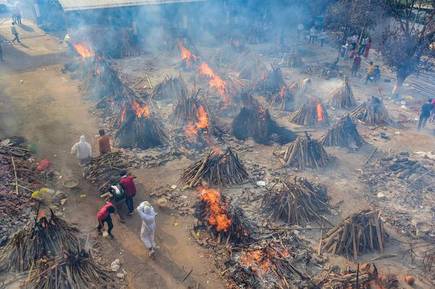Unless its fake news of grand proportions that even Trump would have a problem with, India is now being lit by more fires from funeral pyres than street lights if seen from the distant sky. However while people are gasping for oxygen, dying from a rabid Covid, the leader of the country appears calm but apparently angry about losing Bengal elections and obsessed with bestowing central Delhi with his heritage new buildings that would be a testament to his legacy. The line, ‘While Rome Burns’, never seems to be more apt. Nero was allegedly thinking of new palaces as people burnt and buildings razed to the ground.
There has been criticism from every corner on the handling of the second wave of the corona. From the politically motivated Bengal and the Hindu nationalist Shiv Senna to the objective and most serious medical journal in the world, the Lancet, there are expressions of disbelief. It remains to be seen whether the Indian medical fraternity will now be deprived of the Lancet for criticising the Emperor without his 4.3 crores or $600000 suit.

Udhav Thackeray has targetted the bullet where it probably hurts most. Udhav cannot be called an anti-nationalist by any stretch of the imagination. Nor can he be called a minority-loving liberal. Shiv Senna is as Hindu nationalist as one can get. Thackeray has effectively said that Modi has achieved nothing in his tenure. He said that systems created over 70 years by previous prime ministers such as Pandit Jawaharlal Nehru, Indira Gandhi and Manmohan Singh helped India survive through the tough times being faced today while the present government was not even ready to suspend work on the Central Vista amid a devastating pandemic.
This criticism has come from many quarters including the famous NRI artist sculptor Anish Kapoor in the UK. It does seem very surrealistic and possibly inconsiderate for the building of the project to develop a new Parliament building and a new residence for the Prime Minister to continue while the only news about India around the world is its fast failing medical system and its abysmal preparations for the second wave of Covid. Its poorer countries like Bangladesh and Pakistan are coming to its aid. The world is appalled that the PM is not sitting in Delhi, holding hourly meetings and reassuring his countrymen what steps he is taking to see them through this difficult time. Leadership appears AWOL.

Instead, the news from Government is about a trade deal with the UK and an ongoing trade deal with the EU. Workers who need to be furloughed during the lockdown are instead being bussed into the Central Vista, the genius of Lutyens in central Delhi, to continue building the planned new project to dwarf Luteyen. There is enough money for this project. This is money that could have been used to vaccinate the country.
Yet, we are in strange times. The great hope of a modern rational democratic world demanding accountability from politicians for failed promises and for better opportunities in life seems to be one for the children’s books. From the west to the east, the enlightenment has failed, particularly in democracies. People seem to prefer pain, failure, and poverty while seeking ever more comfort in medieval-type pseudo-religious grand ideas such as Brexit and Hindutva.
Brexit is a delusion built on lost grandeur but herding the English towards isolation and easy prey to predatory trade deals by countries such as the USA and India. The average Brit will be joining the gig economy in greater numbers. Hindutva is delivering Ram Mandir, Central Vista, and Shanshan ghats (crematoriums) on the streets of major cities while promised jobs, money in the bank, or a house for everyone seem to treat as otherworldly. Democracy thrives on psychedelic dreams now.
America is no different. Despite the Biden win, which was a narrow one given the carnage Trump visited on his countrymen, millions and millions of Americans still voted for him, for a baseless slogan Make America Great Again. It needs a Houdini-type political stunt to tell the people of the richest and most powerful country that they have fallen way behind and need to be on top again!
Modi knows that like moths to light, the average person in twenty-first-century democracy is driven more towards esoteric issues than the education and wellbeing of his/her children. So Modi is calmly focused on what will make the populace fold their hands in awe after the many have died around them and remain only in distant memory. The voter will marvel at Central Vista as the triumph of Indian Hindutva over Lutyen. Perhaps this is real post-modernism. Vote for Imagery over food.
MAMTA’S POWERFUL FOOT
It used to be that shakti flowed from the palm of the hand. Traditionally a god, or in Marvel Comics a superhero, holds out the hand, palm facing the enemy and great force emanated from it to throw the enemy many miles into the sky. Mamata has defied the laws of miracles. The Tigress of Bengal has used the sole of her foot from her wheelchair and blown Modi and BJP back into the central vista of Delhi.
Clearly, this state of renowned intellectuals, noble prize winners, and leading thinkers, has not taken to the seduction of Hindu Rashtra. The BJP tried to deploy the whole force of Bahuda (Vedic pluralism) and tolerant Hinduism to turn Bengalis against fellow Muslim Bengalis from the Hindutva version of reconstructed revisionist shastras. Unfortunately, the Bengali is not an Uttar Pradesh or even a Bihari. This land of Tagores, Amartya Sen, and Satyajit Ray has remained true to the original version of a pluralist Vedic and Sanatan Dharma and decided that the tradition of tolerance is more important than the idea of Muslim Mukt Bharat.
So Mamata was able to convince her fellow Bengalis while being wheelchaired around and her foot facing large banners of Modi, that Bengal must remain a land for all, a state for Bengalis of all background, and a state whose people still believe in the famous Vedic statement, ‘Ekam Sat Vipra Bahudha Vadanti’ in earnest rather than a PR slogan at international forums by Hindutva.



















